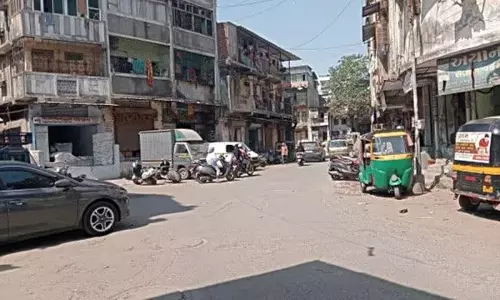The Judge Is Not A Mere Post Office To Frame The Charge At The Behest Of The Prosecution – The Discharge Of Accused In The Jamia Violence Underscores

The Additional Sessions Judge, South East District, Saket Court, Arul Varma, in State vs Mohd. Ilyas@ Illen, delivered an order on Saturday, which is significant for establishing when an assembly of persons protesting against what is perceived as unjust, becomes illegal. The order is also noteworthy to ascertain whether the action taken by the police against individuals exercising...
The Additional Sessions Judge, South East District, Saket Court, Arul Varma, in State vs Mohd. Ilyas@ Illen, delivered an order on Saturday, which is significant for establishing when an assembly of persons protesting against what is perceived as unjust, becomes illegal. The order is also noteworthy to ascertain whether the action taken by the police against individuals exercising their right to protest has blurred the distinction between legitimate protest and a violent uprising.
All incidents of mass violence resulting in clashes between the protestors and the police begin with individuals seeking to express their grievance against a law or an executive action or inaction. Every incident of mass violence, therefore, has to be investigated in order to punish the guilty.
However, when many persons stand accused in an incident of mass violence, their trial and conviction should not compromise on standards of evidence required to establish their culpability. If prima facie, such standards of evidence are missing at the threshold of trial, the judge, responsible for framing the charges, should hesitate to proceed, and instead look at the hard facts before him, whether a trial would really make sense, given the gaps in investigation, and evidence-gathering by the police.
On December 12, 2019, the students of Jamia Millia Islamia University, Delhi, gave a call to gather at Gate No.7 on march towards Parliament House. Prohibitory orders under section 144 Cr.P.C. were in force in the area around the Parliament House, and not near the University. The allegation was that some protestors became aggressive and began throwing stones at the police.
The first chargesheet, filed on April 21, 2020, named only one accused, Mohd Ilyas @ Allen. The second supplementary chargesheet, filed subsequently, named 11 other accused.
The third supplementary chargesheet was filed on February 1 this year, close to the date when the court was to frame charges against the accused, in order to fill the lacuna investigation, as the question of non-identification of accused by police witnesses was raised during the arguments. The court expressed its disappointment that these supplementary chargesheets, rather than adducing fresh evidence, would have the effect of trampling the rights of accused persons.
The accused were implicated under Section 141 IPC read with Section 149 IPC. Under Section 141, an assembly of five or more persons is designated an “unlawful assembly”, if the common object of the persons composing that assembly is, among other things, to resist the execution of any law, or any legal process or to commit any mischief or criminal trespass, or other offence.
The police alleged that the crowd crossed the barricades and broke the signposts and thus were liable to be punished under Prevention of Damage to Public Property Act. The police also submitted that stone pelting ensued whereby 15 police officers sustained injuries, and thus Section 308 IPC was also invoked.
The police claimed that the accused were prima facie guilty under Clause (5) of Section 141 IPC, as the police personnel, at the barricades, were legally bound to forbid the crowd from proceeding beyond the barricades, but were resisted by them. Thus, the accused, even if they were not legally unlawful when they assembled, became so subsequently, the police alleged.
The police submitted that mere presence of the accused at the protest site is sufficient, and no overt act by them is required to complete the offence. Judge Varma relied on the Supreme Court’s judgment in Musa Khan & Others vs State of Maharashtra (1977), to hold that the accused must have been a member of the unlawful assembly at all the crucial stages, and shared the common object of the assembly at all these stages. Judge Varma held that mere presence of the accused at the spot sans any overt acts, cannot inculpate them. No overt act or participation in the commission of offences was attributed to the accused, and there were no eyewitnesses who could substantiate the version of the police that the accused were in any way involved in the commission of the offences.
More important, none of the police witnesses, when speaking specifically of the accused herein, have given statements under section 161 CrPC qua breaking of barricades by the accused. Judge Varma did not find anything on record to even prima facie suggest that the accused were part of some riotous mob. None of the accused, he found, were brandishing any weapon or throwing any stones etc. Prima facie, he found no evidence that the accused resisted the execution of any law.
The Judge relied on State of Karnataka v Chikkahottappa @ Varade Gowda and Others, (2008) to hold that when an offence is committed in prosecution of the common object, it would generally be an offence which the members of the unlawful assembly knew was likely to be committed in prosecution of the common object. He, therefore, found that the chargesheet fails to elaborate what inculpatory or unlawful common object has been attributed to the accused. Also, there was not an iota of evidence qua sharing of the common object by the accused with each other, and with the crowd in general.
Vicarious liability
More significant, Judge underlined that positive knowledge that their sloganeering would result in such a maelstrom, is something that cannot be attributed to the accused sans any cogent proof. There was no proof of the accused persons interacting with each other, which could lend credence to the assertions of the State that there existed a conspiracy between them. Importantly, there were no WhatsApp chats or SMSs between them.
In Masalti vs State of Uttar Pradesh (1964), 40 accused belonging to a village faction and constituting an unlawful assembly were put up on trial for murdering five persons of the other faction with guns. The trial judge found 35 of them guilty, and sentenced 10 of them to death, and the remaining to life imprisonment. The High Court acquitted seven of them, and confirmed the 10 death sentences, while dismissing the appeals of the rest. The Supreme Court commuted the death sentences of three young accused to life imprisonment.
Masalti is a useful precedent as to the number of witnesses to establish the case of prosecution, in cases of unlawful assembly. It lays down the law for dealing with cases of those accused who are sought to be made vicariously responsible for the acts committed by others, only by virtue of their alleged presence as members of the unlawful assembly without any specific allegations of overt acts committed by them. The Supreme Court held in this case that seven accused persons were acquitted by the High Court, because their cases did not satisfy the mechanical test of four witnesses. The requirement of four eyewitnesses has been reiterated by the Supreme Court in another case, namely, State of Uttar Pradesh v Dan Singh (1997).
Applying this test, it was concluded that the prosecution failed to produce a sufficient number of witnesses against each of the 11 accused. He asked if accused Safoora Zargar was allegedly in a muffled face, as per the photos attached, how did the police could identify her.
Further, up until filing of belated chargesheets, for accused Asif Iqbal Tanha, Sharjeel Imam, Mahmood Anwar, Mohd Qasim and Mohd Bilal Nadeem, there were no eyewitness confirming their presence on the spot, Judge Varma found. It was only in the third supplementary chargesheet - whose credibility is doubtful, because it is an afterthought - that witnesses have identified them.
The Judge Varma has also highlighted an inconsistency: While a police witness has identified one accused - Mohd Illyas @ Allen - the rest of the police witnesses only made identical statements that they can recognize the rioters, without actually identifying one, till the filing of a third supplementary chargesheet. Is the police so unsure about its case, Judge Varma asked.
Besides, at least four persons mentioned by two independent witnesses were not named as accused by the police. Judge Varma added that police arbitrarily chose to array some people from the crowd as accused, and others from the same crowd, as police witnesses. This cherry picking by the police, he said, is detrimental to the precept of fairness, he concluded.
The presence of four of the accused on the spot was disclosed by the testimony of other co-accused, who are not witnesses. Judge Varma held that only the confessional statement of co-accused cannot form the basis for framing of charge against other accused.
Ubiquitous power disparity
The conclusion that the prosecution has ex facie been launched in a perfunctory and cavalier fashion against the 11 accused, except qua Mohd Ilyas @ Allen, should alert future courts from proceeding to frame charges against such accused, if the evidence is insufficient.
The Additional Sessions Court aptly relies on the Supreme Court’s judgment in P.Vijayan vs State of Kerala (2010) to hold that the court is duty bound to lean towards an interpretation which protects the rights of the accused, given the ubiquitous power disparity between them and the state machinery. His observation is significant especially, as some of the accused in this case have been arraigned in the larger conspiracy in Delhi riots cases under the draconian Unlawful Activities (Prevention) Act.
The words "not sufficient ground for proceeding against the accused" in Section 227 Cr.P.C. - dealing with the law on discharge - clearly show that the judge is not a mere post office to frame the charge at the behest of the prosecution, but has to exercise his judicial mind to the facts of the case in order to determine whether a case for trial has been made out by the prosecution.




